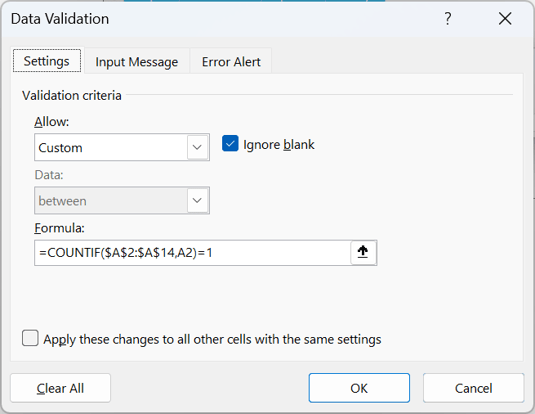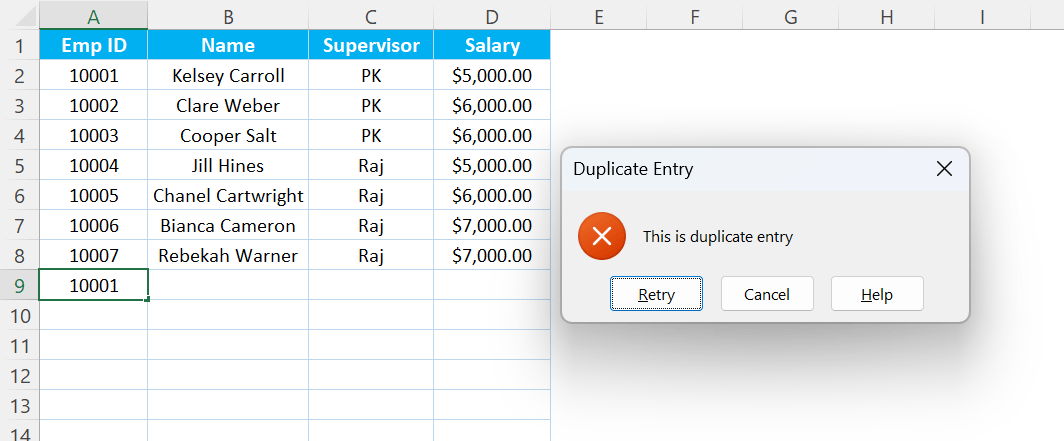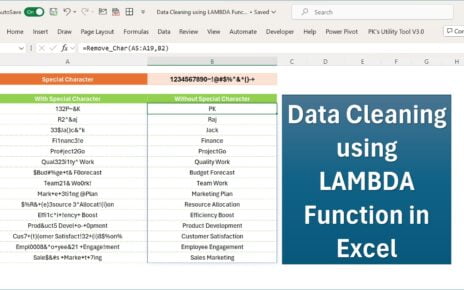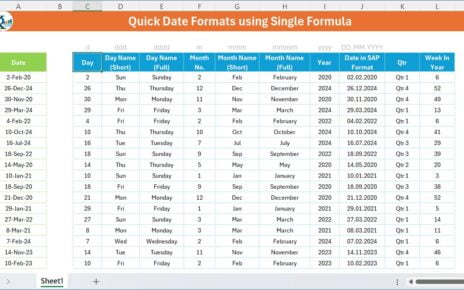Microsoft Excel is a powerful tool that can help you manage and organize large amounts of data. However, one frequent problem that many users face is the issue of duplicate entries. Duplicate entries are a big challenge while working with large data sets because they can skew your data and cause errors. Fortunately, In the Microsoft Excel, we have a feature data validation. It can help you prevent duplicate entries from being added to your data.
In this article, we will tell you how to prevent duplicate entries in Excel using data validation with formula.
Setting up Data Validation to Prevent Duplicate Entries:
Data validation is a very powerful feature in Microsoft Excel. It can help you to prevent incorrect data entry into a cell or range of cells.
The first step to preventing duplicate entries is to select the range wherein you want to prevent duplicates. Once you have selected the range, you can access the Data validation feature in Excel by following these steps:
- Step 1: Go to the Data tab on the Excel ribbon.
- Step 2: Click on the Data Validation button in the Data Tools group or press shortcut key Alt+D+L
- Step 3: In the Data Validation dialog box, select the Settings tab.
- Step 4: Select the “Custom” validation option from the Allow dropdown menu.
- Step 5: In the Formula field, enter a formula that will prevent duplicates. For example, you can use the formula “=COUNTIF($A$1:$A$10,A1)=1“. This formula checks the range A1:A10 and ensures that the value being entered into the cell is unique.
- Step 6: Click on the OK button to save the data validation settings.

Once you have completed these steps, the data validation feature will be enabled for the selected range. Excel will prevent users from entering duplicate entries.
Using the Data Validation Feature to Prevent Duplicates in Real-life Scenarios:
Now as you know how to set up data validation to prevent duplicates, let’s have a look at some real-life scenarios where this feature can be useful.
Preventing Duplicate Names in a List:
One common scenario wherein you might want to prevent duplicates is while you are creating a list of names. For example, you might be creating a guest list for a party or a list of employees. To prevent duplicate entry of names, you can set up data validation for the range wherein you will enter names. In this case, you would select the range of cells wherein you will enter the names, use the same formula we used earlier as given below-
“=COUNTIF($A$1:$A$10,A1)=1”.
This formula will ensure that no duplicate names are entered into the list.
Preventing Duplicate Order Numbers in a Sales Log:
Another scenario wherein you might want to prevent duplicates is while you are tracking sales orders. In this case, you would want to prevent duplicate order numbers entry into the sales log. To do this, you would select the range of cells wherein you will enter the order numbers. Use this formula “=COUNTIF($A$1:$A$10,A1)=1”. It will ensure that each order number is unique and there are no duplicate entry into the sales log.
Preventing Duplicate Product Codes in an Inventory List:
If you are managing an inventory list, you might want to prevent duplicate product code entry. This can be important to ensure that you have accurate information about your inventory levels. To prevent duplicates, you need to select the range of cells wherein you will enter the product codes. Use the formula as given below –
"=COUNTIF($A$1:$A$10,A1)=1".
This will ensure that each product code is unique and that no duplicates are entered into the inventory list.
Preventing Duplicate Employee IDs in a Human Resources Database:
If you are managing a human resources database, then you might want to prevent duplicate employee IDs entry. This can be important to ensure that you have accurate information about your employees and their employment status. To prevent duplicates, you would select the range of cells wherein the employee IDs will be entered and use the formula as given below –
"=COUNTIF($A$1:$A$10,A1)=1".
This will ensure that each employee ID is unique and that no duplicates are entered into the HR database.

Additional Tips and Tricks for Using Data Validation to Prevent Duplicates:
In addition to the basic steps, we have outlined above, there are a few additional tips and tricks you can use to make data validation even more effective for preventing duplicates.
Using Named Ranges to Make Data Validation Easier to Manage:
One useful feature in Excel is Named ranges. Named ranges help to assign a name to a range of cells. Which makes it easier to manage your data validation settings. To create a named range, simply select the range of cells you want to name, then go to the Formulas tab and click on the Name Manager button. In the Name Manager dialog box, click on the “New” button to create a new named range. Use this named range in your data validation settings instead of the cell range. Press F3 shortcut Key to open the Paste name window in your data validation box.
Conclusion:
In conclusion, preventing duplicate entries is an important task. Make error less entry using data validation in Microsoft Excel. In this article, we have shown how to use data validation with formula to prevent duplicate entry. We have also explained a few real-life examples wherein this data validation feature can be useful. We have also explained additional tips and tricks to make data validation even more effective for preventing duplicates. You can ensure that your data is accurate and reliable after using these tips. It will help you make better decisions based on your data.
Visit our YouTube channel to learn step-by-step video tutorials


